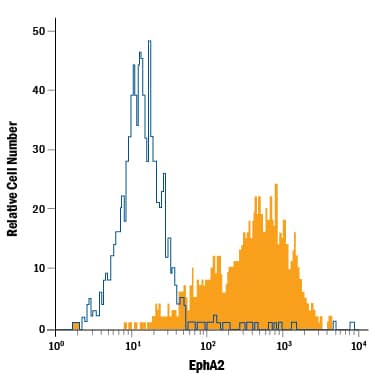Human EphA2 PE-conjugated Antibody
R&D Systems, part of Bio-Techne | Catalog # FAB3035P


Key Product Details
Species Reactivity
Validated:
Cited:
Applications
Validated:
Cited:
Label
Antibody Source
Product Specifications
Immunogen
Gln25-Asn534
Accession # P29317
Specificity
Clonality
Host
Isotype
Scientific Data Images for Human EphA2 PE-conjugated Antibody
Detection of EphA2 in A431 Human Cell Line by Flow Cytometry.
A431 human epithelial carcinoma cell line was stained with Mouse Anti-Human EphA2 PE-conjugated Monoclonal Antibody (Catalog # FAB3035P, filled histogram) or isotype control antibody (Catalog # IC003P, open histogram). View our protocol for Staining Membrane-associated Proteins.Applications for Human EphA2 PE-conjugated Antibody
Flow Cytometry
Sample: A431 human epithelial carcinoma cell line
Formulation, Preparation, and Storage
Purification
Formulation
Shipping
Stability & Storage
- 12 months from date of receipt, 2 to 8 °C as supplied.
Background: EphA2
EphA2, also known as Eck, Myk2, and Sek2, is a member of the Eph receptor tyrosine kinase family which binds Ephrins A1, 2, 3, 4, and 5 (1, 2, 3, 4). A and B class Eph proteins have a common structural organization. The human EphA2 cDNA encodes a 976 amino acid (aa) precursor including a 24 aa signal sequence, a 510 aa extracellular domain (ECD), a 24 aa transmembrane segment, and a 418 aa cytoplasmic domain. The ECD contains an N-terminal globular domain, a cysteine-rich domain, and two fibronectin type III domains (5). The cytoplasmic domain contains a juxtamembrane motif with two tyrosine residues, which are the major autophosphorylation sites, a kinase domain, and a Sterile Alpha Motif (SAM) (5). The ECD of human EphA2 shares 90‑94% aa sequence identity with mouse, bovine, and canine EphA2, and approximately 45% aa sequence identity with human EphA1, 3, 4, 5, 7, and 8. EphA2 becomes autophosphorylated following ligand binding (6, 7) and then interacts with SH2 domain-containing PI3-kinase to activate MAPK pathways (8, 9). Reverse signaling is also propagated through the Ephrin ligand. Transcription of EphA2 is dependent on the expression of E-Cadherin (10), and can be induced by p53 family transcription factors (11). EphA2 is upregulated in breast, prostate, and colon cancer vascular endothelium. Its ligand, EphrinA1, is expressed by the local tumor cells (12, 13). In some cases, EphA2 and EphrinA1 are expressed on the same blood vessels (14). EphA2 signaling cooperates with VEGF receptor signaling in promoting endothelial cell migration (13). The gene encoding human EphA2 maps to a region on chromosome 1 which is frequently deleted in neuroectodermal tumors (15).
References
- Poliakov, A. et al. (2004) Dev. Cell 7:465.
- Surawska, H. et al. (2004) Cytokine Growth Factor Rev. 15:419.
- Pasquale, E.B. (2005) Nat. Rev. Mol. Cell Biol. 6:462.
- Davy, A. and P. Soriano (2005) Dev. Dyn. 232:1.
- Bohme, B et al. (1993) Oncogene 8:2857.
- Pandey, A. et al. (1995) Science 268:567.
- Bartley, T.D. et al. (1994) Nature 368:558.
- Pandey, A. et al. (1994) J. Biol. Chem. 269:30154.
- Miao, H. et al. (2001) Nat. Cell Biol. 3:527.
- Orsulic, S. and R. Kemler (2000) J. Cell Sci. 113:1793.
- Dohn, M. et al. (2001) Oncogene 20:6503.
- Zelinski, D.P. et al. (2001) Cancer Res. 61:2301.
- Brantley, D.M. et al. (2002) Oncogene 21:7011.
- Ogawa, K. et al. (2000) Oncogene 19:6043.
- Sulman, E.P. et al. (1997) Genomics 40:371.
Alternate Names
Gene Symbol
UniProt
Additional EphA2 Products
Product Documents for Human EphA2 PE-conjugated Antibody
Product Specific Notices for Human EphA2 PE-conjugated Antibody
For research use only